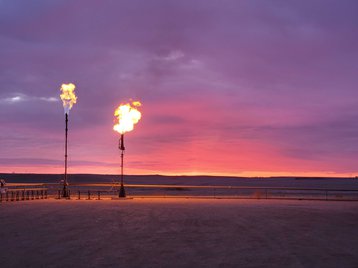Crusoe Energy has launched a service which reduces waste at oil wells by harnessing energy from gas flares and using it for computation.
The Digital Flare Mitigation service will use energy generated from otherwise "stranded" energy sources like gas flares, where natural gas is often simply burnt at the oil well, because it is uneconomic to collect it or convert it to electricity. Instead of being wasted, the energy will be usd to perform cryptocurrency mining, rendering, machine learning, and other use cases on Island Cloud, an Nvidia-powered GPU-centric hardware platform.
Crusoe says this means the service has a fraction of the environmental impact of similar services.
Flare-powered data
Crusoe was founded in 2018 and already has 40 flare-powered data centers with oil producers in North Dakota, Montana, Wyoming, and Colorado, with companies including Devon Energy, Kraken Oil & Gas, and Enerplus. In April, the company raised $128 million in Series B funding to commercialize the service. Existing compute customers include Massachusetts Institute of Technology’s Computer Science and Artificial Intelligence Lab (MIT-CSAIL), Folding@Home, and OpenCV.
The process actually reduces the total emissions from the oil flares, by burning the gas more efficiently to produce less methane. Crusoe says this reduces methane emissions by approximately 98 percent. It also claims an overall reduction in CO2-equivalent emissions of 63 percent, based on the fact that methane is 80 times more potent than CO2 as a greenhouse gas - although the equivalence may be complicated by the fact that methane only lingers in the atmosphere for 12 years before breaking down to CO2 and water, while CO2 remains for centuries.
The Crusoe data center is a modular steel structure with security access controls, dust-proof vestibules, redundant HVAC cooling, and fire suppression systems. Customers pay for power at flat monthly rates, and can have a rack power density from 12.5kW to 25kW per rack, or 250kW per module. The service can scale up to multiple megawatts. The system has a dual-feed design with an uninterruptible power supply (UPS).
The initial installation is in the Williston Basin of North Dakota and Montana, which Crusoe says offers "a discreet, diverse environment with low risk of natural disasters," but data is always available through a high-bandwidth fiber-optic network with microwave backup.
Crusoe promises 99.95 percent service availability, with connectivity to anywhere on the public Internet, with data rates from 1Gbps to 100Gbps. There's a round-trip latency of less than 60ms to anywhere on the US continent, 160ms to Europe, and 180ms to Asia.




